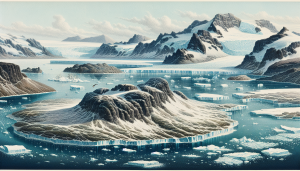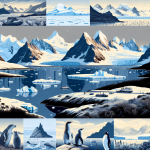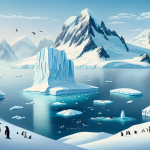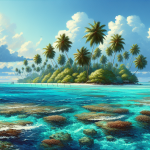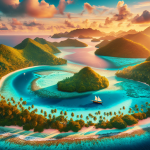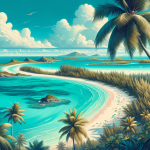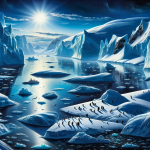Bouvet Island: The Most Remote Island on Earth
Bouvet Island, often cited as the most remote island on Earth, is a fascinating and mysterious destination that has captivated travelers, researchers, and adventurers for centuries. Located in the South Atlantic Ocean, approximately 1,600 kilometers south of the coast of South Africa and 2,500 kilometers southwest of the South Pole, Bouvet Island is an uninhabited, ice-covered volcanic island that belongs to Norway. Its remoteness and harsh climate make it one of the least visited places on the planet. Despite its inaccessibility, Bouvet Island has a rich history and unique ecological significance that make it a subject of great interest. In this article, we will delve into the captivating allure of Bouvet Island, exploring its history, geography, and the challenges it presents to those who dare to visit. We will also discuss the island’s role in scientific research and its significance in global geopolitics. So, if you’re intrigued by the idea of exploring one of the world’s last true frontiers, read on to discover everything you need to know about Bouvet Island.
History of Bouvet Island
The history of Bouvet Island is as remote and enigmatic as the island itself. Discovered in 1739 by French explorer Jean-Baptiste Charles Bouvet de Lozier, the island was initially mistaken for a part of Antarctica. Bouvet’s expedition was unable to land on the island due to the treacherous ice and rough seas, and it wasn’t until nearly two centuries later that the island was officially mapped and claimed. In 1927, Norway declared sovereignty over Bouvet Island, and it was designated as a nature reserve in 1971. Over the years, various expeditions have visited the island, primarily for scientific research, but the harsh conditions and unpredictable weather have made sustained human presence nearly impossible. Despite its isolation, Bouvet Island has played a role in global geopolitics, particularly during the Cold War when it was considered a potential site for secret military installations. Today, the island remains a pristine and protected wilderness, offering a glimpse into a world untouched by human development.
Early Exploration
The initial discovery of Bouvet Island by Jean-Baptiste Charles Bouvet de Lozier in 1739 marked the beginning of the island’s recorded history. Bouvet’s expedition, funded by the French East India Company, aimed to find new territories in the southern oceans. However, the island’s harsh weather and icy terrain thwarted Bouvet’s attempts to land, and the island remained largely uncharted for many years. Subsequent expeditions in the 19th and early 20th centuries also struggled to reach the island, with many explorers mistaking it for a part of the Antarctic continent.
Norwegian Sovereignty
It wasn’t until 1927 that Bouvet Island’s status was clarified. Norwegian whaling captain Harald Horntvedt led an expedition to the island, successfully landing and raising the Norwegian flag. Norway formally annexed the island in 1930, and it was later designated as a nature reserve in 1971. This designation aimed to protect the island’s unique ecosystem and ensure that it remained free from human interference.
Geography and Climate
Bouvet Island’s geography and climate are among the most extreme in the world, contributing to its reputation as the most remote island on Earth. The island is roughly circular, with an area of about 49 square kilometers (19 square miles). It is almost entirely covered by glaciers, with the highest point, Olavtoppen, reaching 780 meters (2,559 feet) above sea level. The island’s coastline is characterized by steep cliffs and rocky shores, making landings extremely challenging. The climate is harsh and inhospitable, with average temperatures ranging from -1°C (30°F) in the summer to -12°C (10°F) in the winter. The island experiences frequent storms, high winds, and heavy snowfall, further complicating any attempts to visit or conduct research.
Volcanic Origins
Bouvet Island’s rugged landscape is the result of its volcanic origins. The island is the summit of a shield volcano that rises from the ocean floor. Although the volcano is considered dormant, its last known eruption likely occurred in the Holocene epoch. The island’s volcanic nature contributes to its unique geological features, including lava flows and basaltic rock formations.
Ecological Significance
Despite its harsh conditions, Bouvet Island is home to a variety of wildlife, particularly seabirds and seals. The island’s remote location and protected status have allowed these species to thrive in an environment largely free from human disturbance. Notable inhabitants include the Antarctic petrel, the South Polar skua, and several species of seals, including the Antarctic fur seal and the southern elephant seal. The island’s rich marine ecosystem also supports a diverse array of fish and invertebrates, making it an important site for biological research.
Challenges of Visiting Bouvet Island
Visiting Bouvet Island is not for the faint of heart. The island’s extreme remoteness, harsh climate, and difficult terrain present significant challenges to even the most experienced adventurers. The nearest inhabited land is Tristan da Cunha, located over 2,000 kilometers (1,200 miles) away, and the island itself is surrounded by treacherous seas and thick ice. There are no permanent human settlements on the island, and the only structures are a few temporary research huts and weather stations. Accessing the island typically requires a long and perilous journey by ship, often through rough seas and icebergs.
Logistical Hurdles
One of the primary challenges of visiting Bouvet Island is the logistical complexity involved. The island’s remote location means that expeditions must be meticulously planned and well-funded. Ships capable of navigating the icy waters and rough seas are essential, and these vessels often need to be specially equipped for polar conditions. Additionally, the unpredictable weather can cause delays and force expeditions to turn back before reaching the island. The lack of infrastructure on the island itself also means that visitors must be entirely self-sufficient, bringing all necessary supplies and equipment with them.
Environmental Considerations
The pristine nature of Bouvet Island means that any visit must be conducted with the utmost care to avoid disturbing the delicate ecosystem. Strict environmental regulations govern activities on the island, and permits are required for any scientific research or exploration. Visitors must adhere to guidelines designed to minimize their impact, such as avoiding nesting areas and disposing of waste properly. The island’s designation as a nature reserve underscores the importance of preserving its unique environment for future generations.
Scientific Research on Bouvet Island
Bouvet Island’s isolation and unique ecosystem make it a valuable site for scientific research. Over the years, various expeditions have studied the island’s geology, climate, and biology, contributing to our understanding of this remote environment. Research on Bouvet Island often focuses on topics such as glaciology, volcanology, and marine biology. The island’s protected status and lack of human activity provide a rare opportunity to study natural processes in an undisturbed setting.
Glaciology and Climate Studies
The glaciers covering Bouvet Island offer a wealth of information about the island’s climate history and the broader patterns of climate change in the region. Researchers study the ice cores extracted from these glaciers to analyze past temperature and precipitation patterns, providing insights into how the climate has evolved over time. Additionally, the island’s harsh weather conditions make it an ideal location for testing and developing new technologies for polar research.
Marine Biology
The rich marine ecosystem surrounding Bouvet Island is another area of interest for scientists. The cold, nutrient-rich waters support a diverse array of marine life, including fish, invertebrates, and marine mammals. Researchers study these species to understand their behavior, population dynamics, and interactions with the environment. The island’s isolation also makes it an important site for studying the impacts of climate change and human activities on marine ecosystems.
Bouvet Island in Global Geopolitics
Despite its remote location, Bouvet Island has played a role in global geopolitics, particularly during the Cold War. The island’s strategic position in the South Atlantic Ocean made it a potential site for military installations and surveillance operations. While there is no evidence that any such facilities were ever established, the island’s sovereignty and strategic importance have been subjects of interest for various nations.
Cold War Era
During the Cold War, the South Atlantic region was a focal point for geopolitical tensions between the United States and the Soviet Union. Bouvet Island’s remote location and harsh conditions made it an unlikely but potential site for secret military activities. Speculation about the island’s use for covert operations persisted, although no concrete evidence has ever been found. The island’s inhospitable environment and lack of infrastructure likely made it impractical for sustained military presence.
Current Geopolitical Significance
Today, Bouvet Island remains under Norwegian sovereignty and is governed as a nature reserve. Its strategic importance has diminished in the post-Cold War era, but the island’s protected status and unique ecosystem continue to make it a subject of interest for environmental and geopolitical researchers. The island’s isolation and pristine environment also contribute to its significance as a site for scientific research and conservation efforts.
Conclusion: The Allure of Bouvet Island
Bouvet Island, with its status as the most remote island on Earth, presents a unique combination of challenges and opportunities for those who dare to explore its icy shores. From its discovery by early explorers to its role in scientific research and global geopolitics, the island’s history is as fascinating as its geography is forbidding. The harsh climate, treacherous seas, and lack of infrastructure make visiting Bouvet Island an endeavor that requires careful planning, significant resources, and a deep respect for the delicate ecosystem. Despite these challenges, the island’s pristine environment and unique ecological significance offer a rare glimpse into a world largely untouched by human activity. For researchers, adventurers, and conservationists, Bouvet Island remains a captivating destination that continues to intrigue and inspire. Whether you dream of embarking on an expedition to this remote frontier or simply wish to learn more about one of the world’s last true wildernesses, Bouvet Island offers a wealth of stories and discoveries waiting to be uncovered.
For more information about the history and exploration of Bouvet Island, visit the Norwegian Polar Institute.
